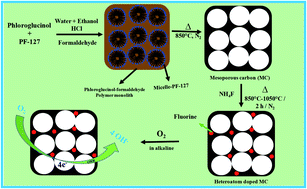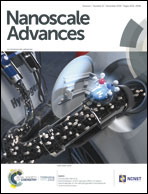Fluorine-enriched mesoporous carbon as efficient oxygen reduction catalyst: understanding the defects in porous matrix and fuel cell applications
Abstract
Herein, fluorine enrichment in mesoporous carbon (F-MC) was explored to introduce maximum charge polarization in the porous matrix, which is beneficial for the preferential orientation of O2 molecules and their subsequent reduction. Ex situ doping of F to porous carbon derived from phloroglucinol–formaldehyde resin using Pluronic F-127 as a structure-directing agent is standardized. The optimized F-MC catalyst exhibited excellent electrocatalytic activity towards the oxygen reduction reaction (ORR) in alkaline media (0.1 M KOH) with an onset potential of −0.10 V vs. SCE and diffusion-limiting current of 4.87 mA cm−2, while displaying only about 50 mV overpotential in the half-wave region compared to Pt–C (40 wt%). In the stability test, the catalyst showed only 10 mV negative shift in its half-wave potential after 10 000 potential cycles. The rotating ring disk electrode (RRDE) experiments revealed that F-MC follows the most preferable 4e− pathway (n = 3.61) with a moderate peroxide (HO2−) yield. This was further supported by density functional theory calculations and also deeply explains the existence of defects being beneficial for the ORR. The F-MC catalyst owing to its promising ORR activity and long-term electrochemical stability can be viewed as a potential alternative ORR catalyst for anion exchange membrane fuel cell applications.



 Please wait while we load your content...
Please wait while we load your content...